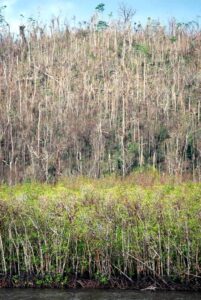Cyclones wreak havoc in northern Australia every summer, risking lives and damaging homes, crops and businesses, as well as having dramatic impacts on natural environments. How will our tropical communities and industries such as agriculture and tourism – and the ecosystems upon which they depend – cope if the intensity of cyclones in the region increases as some climate models predict?
‘Cyclones have always been part of life up here, and north Queenslanders are pretty resilient folk,’ said Ms Carole Sweatman, CEO of Terrain NRM, based in Innisfail in far north Queensland. ‘But everyone worries what could happen to our environment and economy if cyclones hit us more frequently, or if they’re stronger.’
Carole has been very supportive of ecosystem science in the region, partly because her team needs to have the best available information to hand when managing the impacts of tropical cyclones. ‘Better scientific knowledge leads to improved recommendations, guidelines and plans, and means we have greater confidence that our management actions are improving the resilience of our region,’ she said.
Thanks to four decades of long-term environment monitoring effort by a large number of individuals and agencies in the region[1] – recently compiled under the auspices of TERN – we have a good understanding of cyclone impacts and recovery processes in Australia’s Wet Tropics. Importantly, this scientific knowledge has already led to improvements in cyclone preparation, response and management by regional agencies and industry representative bodies, such as Terrain NRM.
‘We have some very long-established rainforest monitoring plots here in the Wet Tropics,’ said Dr Dan Metcalfe of CSIRO, leader of TERN’s Tropical Rainforest Plot Network, part of TERN’s Long Term Ecological Research Network (LTERN). ‘The long-term datasets arising from this research infrastructure mean that we can make scientifically robust conclusions and recommendations for management.’
Because good scientific baselines already existed, the team was able to observe the impacts of and recovery from Cyclone Larry (category 4, March 2006) and Cyclone Yasi (category 5, February 2011) on the region’s rainforests in far greater detail than would otherwise have been possible.
‘Each of those cyclones went right over the top of a number of our forest monitoring plots – virtually destroyed some of them, which was actually very helpful,’ noted Dan. ‘Because we then had information about multiple cyclone impacts on those plots over time, natural experiments if you will, and consequently we could start to unpick our observations of recovery and glimpse some of the underlying ecosystem processes.’
Dan and co-authors have recently put together much of the scientific knowledge gleaned by decades of scientific investigation of cyclone impacts in the region, as part of a book entitled Biodiversity and Environmental Monitoring in Australia, just released by CSIRO Publishing.


Damaged vegetation at Hull Heads, QLD, following Tropical Cyclone Yasi in 2011. Mangrove ecosystems (foreground) seemed to be more resilient than rainforest ecosystems (background) (photo courtesy of Dan Metcalfe, CSIRO).
[1] Including the Australian National University, James Cook University, La Trobe University, University of Cambridge, University of California at Santa Barbara, CSIRO, the US National Science Foundation, the Australian Research Council, Earthwatch, Daintree Discovery Centre and the Queensland Premier’s Department, the Cooperative Research Centre for Tropical Rainforest Ecology and Management (CRC-TREM), the Rainforest CRC and the Marine and Tropical Sciences Research Facility (MTSRF), with additional individual contributions from Dan Metcalfe, Mike Liddell, Matt Bradford, Pete Green, David Hilbert, Joanne Isaac, Helen Murphy, Scott Parsons, Justin Welbergen, David Westcott, Steve Williams, Yvette Williams, Andrew Ford.
Published in TERN newsletter January 2014






